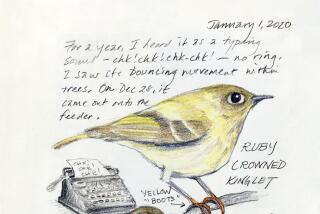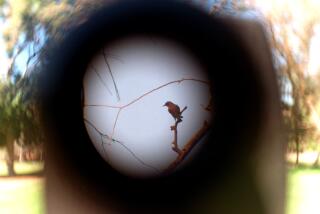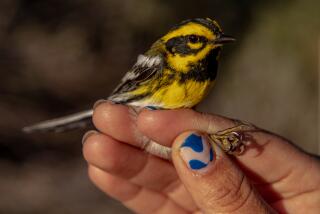Birdman of Connecticut Helped Set the Cardinal Rules of Bird-Watching
- Share via
OLD LYME, Conn. — Although Roger Tory Peterson’s innovative field guides are credited with revolutionizing the art of bird-watching, the famous illustrator says he has no secret recipe when it comes to entertaining the feathered friends he draws so well.
“I’m pretty unimaginative, really,” he said. “Sunflower seeds, cracked corn, suet and a little peanut butter once in a while. That’s about it.”
The birds flitting about Peterson’s yard didn’t seem to have any complaints on this particular day.
They were busily pecking away as the lanky, white-haired naturalist sat on a couch in his studio, observing the yard through one of two large picture windows in the room.
From one window, a black-capped chickadee could be seen carefully selecting a sunflower seed in a feeder suspended between two trees. On the other side of the yard, a red-bellied woodpecker clung to a tree trunk, while a small army of tufted titmice darted through the tangled branches of a huge, winged euonymus.
Virginia Peterson smiled fondly as her husband watched the titmice capering in the shrub.
“‘Roger likes to have birds around him whenever possible,” she said. “He tends to get bored otherwise.”
This has been true for about 70 years, dating back to when the 84-year-old Peterson was a seventh-grader in Jamestown, N.Y. “My teacher, Blanche Hornbeck, got me interested in drawing birds,” he said.
He soon was drawing, and later photographing, every bird in sight. In the classroom, when no models were available, he would draw birds from memory on the margins of his school books.
Now, seven decades later, Peterson still photographs and draws birds. On this day he has a canvas of Atlantic puffins on his easel.
Despite his age, Peterson still puts in long hours in the studio, but says he finds he must get out into the field every so often or he gets stale.
“I can recognize the calls of practically every bird in North America,” he said. “There are some in Africa I don’t know, though.”
Peterson has been to East Africa 10 times and has lined his studio with exotic tribal masks acquired on these trips. He plans to return to Africa again early this year.
“I’ve birded all over the world,” he said, shrugging. “I’ve been to Antarctica 17 times and four times to Australia. It’s reached the point where I don’t consider the United States to be travel, unless I go to Alaska.”
He thought for a moment, then said, “You know what I’d like to do, I’d like to take a cross-country trip and photograph the birds at every national park and wildlife preserve.”
He glanced again at the birds in his yard. “We really should use more imagination when feeding birds,” he said. “In Africa, they put out boiled rice, which brings in a whole raft of birds, including cuckoos and vultures.”
There were no cuckoos in sight, but Peterson predicted that a pair of not-so-wild turkeys soon would appear.
“It’s hard to say what will get a person interested in birds,” he said, scanning the far reaches of the yard for the tardy turkeys. “In my case it was a flicker I saw when I was 11. I thought it was dead. One moment it was just a bundle of brown feathers. Then suddenly it exploded into life, and I was hooked.”
Then came his seventh-grade teacher, followed by stints at art school in New York City and the River School in Brookline, Mass., where he studied both art and science.
Peterson’s breakthrough came in 1934 with the publication of his field guide to the birds of the Eastern United States. It was the first field guide to contain a schematic arrangement of birds and detailed illustrations that contained tiny arrows pointing to primary identifying features.
Although the concept seems obvious, the book was considered revolutionary when it came out.
Peterson savored the moment as he recalled his triumph.
“Several publishers had turned me down,” he said, “but Houghton Mifflin decided to take a chance on me. They initially brought out only 2,000 copies. They were all sold within a week, and the bookstores were calling for more.”
Since then, he said, his various field guides--which include studies of birds throughout most of the world, and of butterflies, beetles and wildflowers as well--have sold 15 million copies.
Virginia Peterson does the elegant, detailed maps in her husband’s field guides. The maps are based on careful studies of published reports and visual sightings by birders. She said the range maps are particularly difficult to pin down because the ranges of many birds tend to change constantly.
“For instance,” said Peterson, “I can remember when you never saw a tufted titmouse east of the Hudson River. On the other hand, in recent years the loggerhead shrike has virtually disappeared from the Northeast.”
Peterson has seen bird-watching become enormously popular during his lifetime. He says he is gratified by the role he has played in this phenomenon.
“Nowadays,” he said, “some people even try to make birding a competitive sport, vying with each other to see who can spot the most species.”
Although he says he doesn’t engage in this type of birding, Peterson recently issued a series of cards, patterned after the commercial baseball cards popular with collectors. Peterson’s cards portray birds from one of his field guides, plus a biographical sketch of the bird and a range map.
“Since some people are determined to make birding a sport, we thought we might as well capitalize on the situation,” he said. “But, actually, the cards are quite nice. They were my wife’s daughter’s idea.”
Houghton Mifflin also has just released a large-format retrospective of Peterson’s field guide drawings. He is admittedly quite proud of the book, and of his perceived place in history, as being a sort of latter-day John James Audubon.
“I consider myself to have been the bridge between the shotgun and the binoculars in bird-watching,” he said. “Before I came along, the primary way to observe birds was to shoot them and stuff them. Some people even have gone as far as to call me the grandfather of the environmental movement.”
More to Read
Sign up for The Wild
We’ll help you find the best places to hike, bike and run, as well as the perfect silent spots for meditation and yoga.
You may occasionally receive promotional content from the Los Angeles Times.






